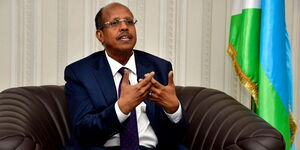The government has intensified efforts to overhaul Kenya's supply chain, with President William Ruto personally challenging the Kenya Medical Supplies Authority (KEMSA) to achieve a 100 per cent order fill rate as soon as possible.
Ruto spoke during a visit to KEMSA’s exhibition stand at the Devolution Conference in Homa Bay County on August 13, where he acknowledged the ongoing reforms within the authority but still reiterated that there was still massive room for improvement.
"We agreed that KEMSA must hit the 100 per cent Order Fill Rate. Healthcare delivery must be efficient and responsive," Ruto said.
"KEMSA must aim for a 100 per cent Order Fill Rate to eliminate delays and ensure patients across the country receive treatment when they need it."
The president's call to action came after KEMSA revealed that the current order fill rate stood at 57 per cent. In what was a direct response to the president's challenge, the authority announced an ambitious 100-day Rapid Results Initiative (RRI), which was launched in July 2025.
As part of a larger transformation agenda at KEMSA, the initiative aims to raise the fill rate to 78 per cent by September 2025. This, according to the authority, will act as a stepping stone to the government's ultimate goal of 100 per cent.
The initiative aims to raise the fill rate to 78 per cent by September 2025 in what is a critical stepping stone to the government's ultimate goal of 100 per cent.
“This initiative is more than a short-term fix,” KEMSA CEO Waqo Ejersa said. “It’s the launchpad for our Sustainable Growth Strategy 2025–2030, which will institutionalise reforms, reinforce good governance, and embed innovation into how we do business.”
Ejersa revealed that the strategy was currently under development and would serve as a five-year roadmap to guide KEMSA towards a fully digitised, transparent and efficient supply system.
KEMSA's transformation is also aligned to the government's Universal Health Coverage (UHC) agenda, which the president has placed at the centre of his government's development blueprint.
For healthcare workers, an improved order fill rate will effectively mean consistent supplies, better planning and a higher ability to meet patients' needs, while for patients, a higher medical supply will eliminate delays and increase confidence in public health services.
Consistent supplies to hospitals also mean patients will have reduced reliance on out-of-pocket spending for medicines - something which has been a challenge for Kenyan households for years.
In June, KEMSA launched a nationwide stocktaking exercise across all its warehouses in a fresh push to restore accountability and accuracy in the country’s health supply chain.
The two-week exercise was expected to cover the physical verification of all Health Products and Technologies (HPTs) against digital records as part of the authority's broader transformation into a demand-driven, data-powered institution capable of ensuring the timely delivery of essential medical supplies.












